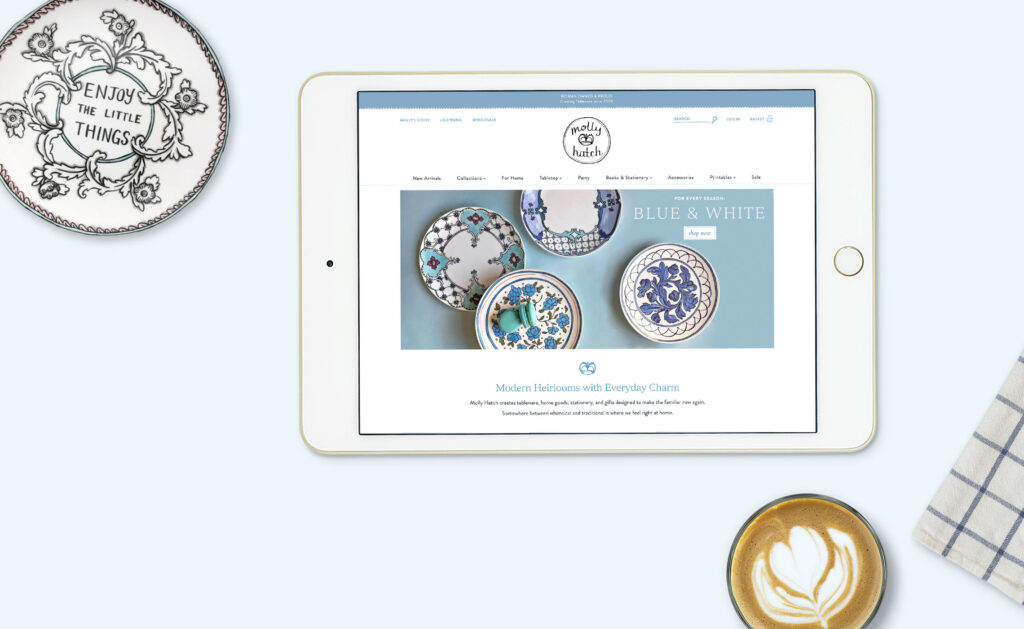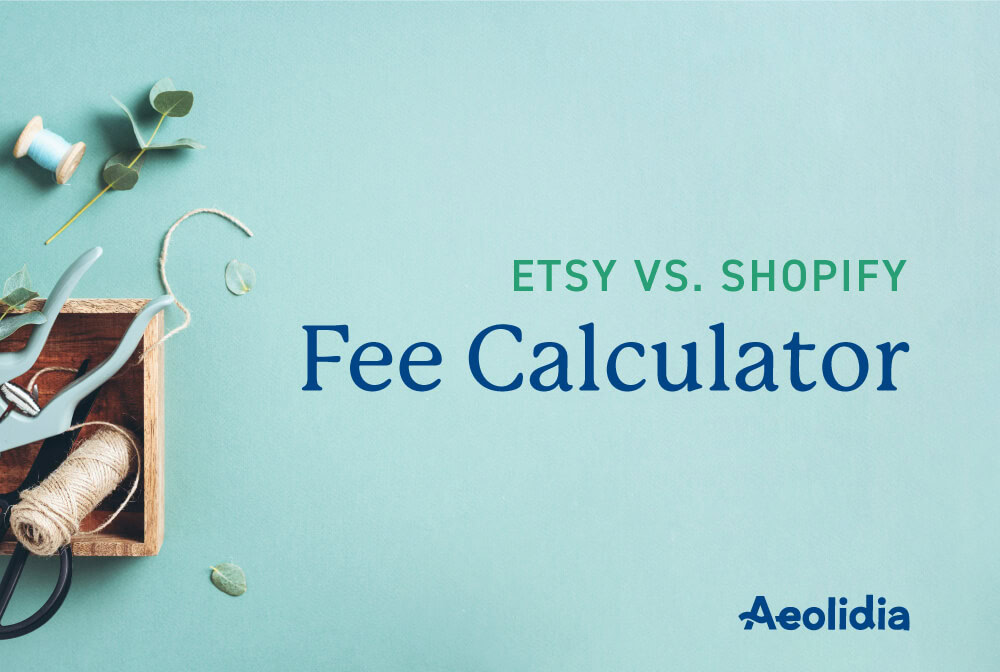
With its massive, built-in community of buyers, search ranking dominance and near-total ownership of the handmade marketplace online, Etsy is a powerful sales platform for entrepreneurs who want to start and grow creative businesses. You would be hard-pressed to launch your own website and reach the sales numbers you can achieve within the first few months of selling handmade goods on Etsy, and that’s why so many sellers flock to the platform as a first step. After a few years, you might you might wonder if you’ve outgrown Etsy.
Maybe your sales have plateaued, or you’re receiving violation notices with Etsy threatening to terminate your account. Maybe you’ve started running Facebook ads and are tired of paying for traffic that you have no control over. Or maybe your product line is expanding to the point where you can no longer adhere to Etsy’s manufacturing policies.
Whatever the reason, many sellers find themselves feeling like their handmade business has outgrown Etsy, and they’re unsure of the next steps. How do you expand your business beyond the limitations of the Etsy platform, and is it worth the extra time and effort to do so?
Are these 6 Etsy issues limiting your business growth?
We’re going to take a look at a number of ways selling only on Etsy can limit your business growth, and we’ll talk about how to assess whether these limitations are just the worthwhile cost of doing business with Etsy, or a sign your business is ready to expand.
The Etsy Algorithm
Etsy’s search algorithm is complex and not fully transparent, so just when you think you’ve mastered getting your products found in search, things change. If you’re only selling on Etsy and your products are no longer discoverable via the Etsy search engine, you could experience a serious drop in sales.
While Etsy is transparent about some of its ranking factors, such as title and tag relevancy and listing quality, some sellers swear their shop traffic dips mysteriously from month to month, or that Etsy puts “sales caps” on their monthly earnings. This may sound conspiratorial, but the underlying frustration is that sellers don’t feel in control of their traffic from Etsy search, their most important acquisition channel.
Is this an issue for you?
If you’re only selling on Etsy and you sometimes experience unexplained stretches with low traffic and zero sales, you may be coming to the realization that you can’t rely on Etsy alone for shop traffic. This means you have to do some marketing to drive traffic to your shop on your own, as Etsy’s built-in marketing engine is no longer working for you. The question then becomes: if you’re doing your own marketing to combat the ebb and flow of Etsy algorithmic changes, do you want to spend that energy (and budget) driving traffic back to Etsy, or to a domain you own?
Etsy Fees
For low-volume businesses, Etsy fees aren’t that much of an issue. Many sellers consider them to be part of the cost of marketing (which they aren’t paying for because Etsy already has a built-in buying audience). But once you start making more sales in your business, the Etsy fees add up, often eclipsing costs you’d pay on other e-commerce platforms. (Check out our blog post on Etsy fees for low versus high-volume shops.)
Is this an issue for you?
At high volume, you can save hundreds—sometimes thousands—of dollars by switching to a platform like Shopify. You can redirect these savings into marketing expenditures to help drive traffic to your new Shopify store. If you want a real-life example of what this looks like, read about how Amy, owner of Little Hip Squeaks (now June & January), came to the conclusion that she was paying too much in Etsy fees.
Use our Etsy vs. Shopify fee calculator to see how much you would save on fees based on your monthly Etsy sales volumes.
No Control Over Your Branding
You may know you’re a legit business owner (you certainly work hard enough!), but when you’re selling solely on Etsy, people sometimes view your business differently. Tricia Lee, owner of KidEssence, summed this phenomenon up perfectly:
I cringe when friends ask, “How’s your Etsy business?” It’s not Etsy’s business, it’s my business that I work extremely hard to build.
Similarly, when someone purchases something from your Etsy shop, they don’t think of it as having been purchased from you.
Stefanie Lin, owner of Oh! You’re Lovely, says:
When people buy a product on Etsy, and a friend asks them where they got [it], the response is normally, “I got it on Etsy,” not the store/artist/brand.
Is this an issue for you?
There are instances when you may want to brand yourself and your shop as something bigger than “Etsy seller” or “Etsy business.” For example, think about the information that goes on a business card you hand to potential wholesale buyers at a trade show. Do you want to use your Etsy shop’s URL, or your own domain? Your own domain certainly looks more professional. And while it’s true that a domain can redirect to an Etsy shop, is that where you want to send potential wholesale customers?
Even if you’re making more sales on Etsy than your own website, just having a website lends legitimacy to your business that is hard to establish on the Etsy platform, and if you need that legitimacy to reach the next step in your business, getting your own domain might be the smart way to get there.
Selling Next Door to Your Competitors
On your own website, you have a bit more control over the user experience than you do on Etsy, where a customer using the search tool might leave your shop and buy a similar product from another business on Etsy.
Is this an issue for you?
While comparison shopping is to be expected, even outside of Etsy, the rules change when you start running ads.
Tiffany Morgan Emery, owner of Adoren Studio, sums it up:
If I am paying to drive the traffic, I want it directed at a higher-converting site that I own that is not showcasing my competition. I paid for that customer, so I want to retain them and put my best foot forward toward making the sale.
If you’re paying for traffic to your Etsy shop, you run the risk of paying for people to buy from your competition. Not a great position to be in!
No Control Over Customer Relationships
Even though people are buying from you on Etsy, Etsy maintains that the email addresses you collect in the course of a transaction can only be used for “Etsy-related communications or for Etsy-facilitated transactions.” Etsy does not allow you to add buyers to your email list, nor do they facilitate any intuitive, high-converting way of capturing the email addresses of people interested in your shop. In essence, there’s no easy way to keep in touch with people who have favorited one of your items or bought something from you.
Is this an issue for you?
Given that e-commerce conversion rates from email marketing are typically high, especially from advanced email marketing tactics like abandoned cart emails, controlling your relationship with your customer via email is important. Email also allows you to foster repeat purchases. If your business has any chance of getting another sale from someone who’s bought from you already, you might consider migrating to a platform where you have better control over building an email list you can actually communicate with.
Restrictions on Product and Production
In the course of running your business, you might need to update your production process in order to scale. Etsy only allows items made by you or a production partner (i.e. “manufacturer”), as long as you’re still the designer. And they have list of 4 critical pieces of information you have to share in every listing if you are working with a manufacturer rather than making the items yourself. While their policies make sense for the platform, they’re a bit restrictive for handmade sellers looking at various options for expanding production. Even if you are meeting the (somewhat nebulous) standards of the policy, Etsy states:
We reserve the right to reject any production partnerships that aren’t in the letter or spirit of this policy, Etsy’s Handmade Policy, or our ethical expectations. We would hate to do it, but if we find that you’re not being open and honest or that your shop violates our policies or ethical expectations, we may suspend or terminate your account.
This means your account could be terminated at any time without warning should you fail to respond to a more detailed inquiry about your manufacturing process.
Is this an issue for you?
If you’re a handmade seller making everything yourself, probably not. But once you venture into the world of hiring others to help with production, your shop and livelihood is at the mercy of Etsy’s cloaked decision making process. Just check out this story from Market Your Creativity’s Lisa Jacobs — who was making her full-time living on Etsy — describing what happened when Etsy decided her shop violated their policies. Once you start expanding your production process, diversifying your revenue streams helps protect you from unwarranted account closures.
Should You Leave Etsy, or Just Diversify?
If you feel your business is outgrowing Etsy, you now have a decision to make:
- Keep your Etsy shop open and add other revenue streams
- Close your Etsy shop and focus solely on new revenue channels
Each choice has its pros and cons.
Wrenay Gomez Charlton, owner of Paper Hive Studio, keeps her Etsy shop open in addition to maintaining her own website. “Etsy is just a sales channel,” she says, “so it’s one of many ways for me to expose my products to potential customers. I view my online shop as my main hub with Etsy, Facebook shop, Instagram shop, craft fairs, trade shows, etc. as strands from that hub — all working to reach new customers and promote my brand.”
With so many sales channels, inventory management can become an issue. If you do decide to keep your Etsy shop open, you should come up with a reliable system for tracking inventory as it sells from multiple platforms.
A few ways to handle this:
- List only your best sellers on Etsy, not your entire product line
- Use Etsy as a clearing house for old inventory and sale items
- Invest in inventory management tool like Craftybase (we know this software has mixed reviews) that can help you track inventory across sales platforms
What Should You Do If You Want to Leave Etsy
If you plan on leaving Etsy entirely, be aware that driving traffic to a brand-spankin’ new online shop isn’t a walk in the park at first. It takes time to build up traffic, especially the kind of traffic you’re used to from Etsy, so plan to work double time for a while, selling on both your website and Etsy.
Some ideas for getting traffic to your new shop:
- Point all your social media accounts to your new domain
- Think about any referral traffic (traffic from other websites, including blogs) you’re currently getting to your Etsy shop. Can you contact the blogger and have them redirect the link to your store domain?
- Start directing Etsy traffic to your website for future orders (you can do this with your digital communication or with postcards included in each order)
- Offer better deals through your website than on Etsy, at least for a while
- Open up your website to wholesale orders, if you offer them
- Consider running paid ads on social media to your new domain
Once traffic on your website ramps up, you can shutter your Etsy shop. But don’t delete your account entirely! Keep it open with no inventory, and use your profile to point to your shop domain. Etsy has fairly liberal linking policies, so it’s okay to include outbound links from your Etsy profile as long as they’re not directing users elsewhere to make a purchase.
It All Starts With a Plan
Whether you’re planning to move from Etsy to Shopify entirely or simply expand your online presence, migrating away from a surefire sales channel is a daunting task — certainly not something you want to take on overnight. Leaving Etsy, or expanding beyond it, should be part of your long-term business planning. Create a list of pros and cons. Experiment with income projections. Make a list of assets you’ll need (a domain name, a website, a marketing budget) in order to make the transition.
While it may feel difficult at first, a move away from a single marketplace channel will ultimately give you more control over your business, and this can only help you grow.
If you feel like youve outgrown Etsy, you need a stellar website to get you to the next level. Want to know what we can do to help you grow? Download our rate sheet.
Etsy vs Shopify Fee Calculator

What will it cost to set up your own shop? Use this calculator to choose a Shopify plan, and compare to your Etsy fees.
Browse Posts
A Newsletter That Goes Beyond Shopify 101
It’s easy to find beginner info about ecommerce online. If you’re past that? Subscribe to our newsletter for advanced strategies and need-to-know info for established shops.
Learn how the top shops grow:
"*" indicates required fields
Related Posts
Let's take your online shop to the next level
The Shopify websites we design have a reputation for substantial improvements to ecommerce conversion rates and online sales. Let's talk!
 Grab my guide to the 10 main ways to grow traffic and optimize to boost sales.
Grab my guide to the 10 main ways to grow traffic and optimize to boost sales.


